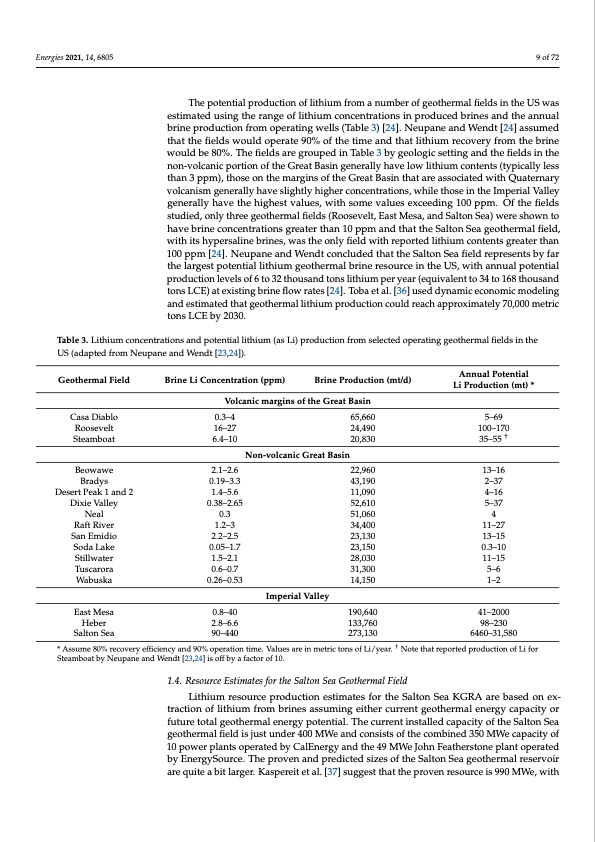
PDF Publication Title:
Text from PDF Page: 009
Energies 2021, 14, 6805 9 of 72 The potential production of lithium from a number of geothermal fields in the US was estimated using the range of lithium concentrations in produced brines and the annual brine production from operating wells (Table 3) [24]. Neupane and Wendt [24] assumed that the fields would operate 90% of the time and that lithium recovery from the brine would be 80%. The fields are grouped in Table 3 by geologic setting and the fields in the non-volcanic portion of the Great Basin generally have low lithium contents (typically less than 3 ppm), those on the margins of the Great Basin that are associated with Quaternary volcanism generally have slightly higher concentrations, while those in the Imperial Valley generally have the highest values, with some values exceeding 100 ppm. Of the fields studied, only three geothermal fields (Roosevelt, East Mesa, and Salton Sea) were shown to have brine concentrations greater than 10 ppm and that the Salton Sea geothermal field, with its hypersaline brines, was the only field with reported lithium contents greater than 100 ppm [24]. Neupane and Wendt concluded that the Salton Sea field represents by far the largest potential lithium geothermal brine resource in the US, with annual potential production levels of 6 to 32 thousand tons lithium per year (equivalent to 34 to 168 thousand tons LCE) at existing brine flow rates [24]. Toba et al. [36] used dynamic economic modeling and estimated that geothermal lithium production could reach approximately 70,000 metric tons LCE by 2030. Table 3. Lithium concentrations and potential lithium (as Li) production from selected operating geothermal fields in the US (adapted from Neupane and Wendt [23,24]). Geothermal Field Casa Diablo Roosevelt Steamboat Brine Li Concentration (ppm) Brine Production (mt/d) Volcanic margins of the Great Basin 0.3–4 65,660 16–27 24,490 6.4–10 20,830 Non-volcanic Great Basin Annual Potential Li Production (mt) * 5–69 100–170 35–55 † 13–16 2–37 4–16 5–37 4 11–27 13–15 0.3–10 11–15 5–6 1–2 41–2000 98–230 6460–31,580 Beowawe 2.1–2.6 Bradys 0.19–3.3 Desert Peak 1 and 2 1.4–5.6 Dixie Valley 0.38–2.65 Neal 0.3 Raft River 1.2–3 San Emidio 2.2–2.5 Soda Lake 0.05–1.7 Stillwater 1.5–2.1 Tuscarora 0.6–0.7 Wabuska 0.26–0.53 East Mesa 0.8–40 Heber 2.8–6.6 Salton Sea 90–440 22,960 43,190 11,090 52,610 51,060 34,400 23,130 23,150 28,030 31,300 14,150 Imperial Valley 190,640 133,760 273,130 * Assume 80% recovery efficiency and 90% operation time. Values are in metric tons of Li/year. † Note that reported production of Li for Steamboat by Neupane and Wendt [23,24] is off by a factor of 10. 1.4. Resource Estimates for the Salton Sea Geothermal Field Lithium resource production estimates for the Salton Sea KGRA are based on ex- traction of lithium from brines assuming either current geothermal energy capacity or future total geothermal energy potential. The current installed capacity of the Salton Sea geothermal field is just under 400 MWe and consists of the combined 350 MWe capacity of 10 power plants operated by CalEnergy and the 49 MWe John Featherstone plant operated by EnergySource. The proven and predicted sizes of the Salton Sea geothermal reservoir are quite a bit larger. Kaspereit et al. [37] suggest that the proven resource is 990 MWe, withPDF Image | Recovery of Lithium from Geothermal Brines

PDF Search Title:
Recovery of Lithium from Geothermal BrinesOriginal File Name Searched:
energies-14-06805-v2.pdfDIY PDF Search: Google It | Yahoo | Bing
Product and Development Focus for Infinity Turbine
ORC Waste Heat Turbine and ORC System Build Plans: All turbine plans are $10,000 each. This allows you to build a system and then consider licensing for production after you have completed and tested a unit.Redox Flow Battery Technology: With the advent of the new USA tax credits for producing and selling batteries ($35/kW) we are focussing on a simple flow battery using shipping containers as the modular electrolyte storage units with tax credits up to $140,000 per system. Our main focus is on the salt battery. This battery can be used for both thermal and electrical storage applications. We call it the Cogeneration Battery or Cogen Battery. One project is converting salt (brine) based water conditioners to simultaneously produce power. In addition, there are many opportunities to extract Lithium from brine (salt lakes, groundwater, and producer water).Salt water or brine are huge sources for lithium. Most of the worlds lithium is acquired from a brine source. It's even in seawater in a low concentration. Brine is also a byproduct of huge powerplants, which can now use that as an electrolyte and a huge flow battery (which allows storage at the source).We welcome any business and equipment inquiries, as well as licensing our turbines for manufacturing.| CONTACT TEL: 608-238-6001 Email: greg@infinityturbine.com | RSS | AMP |